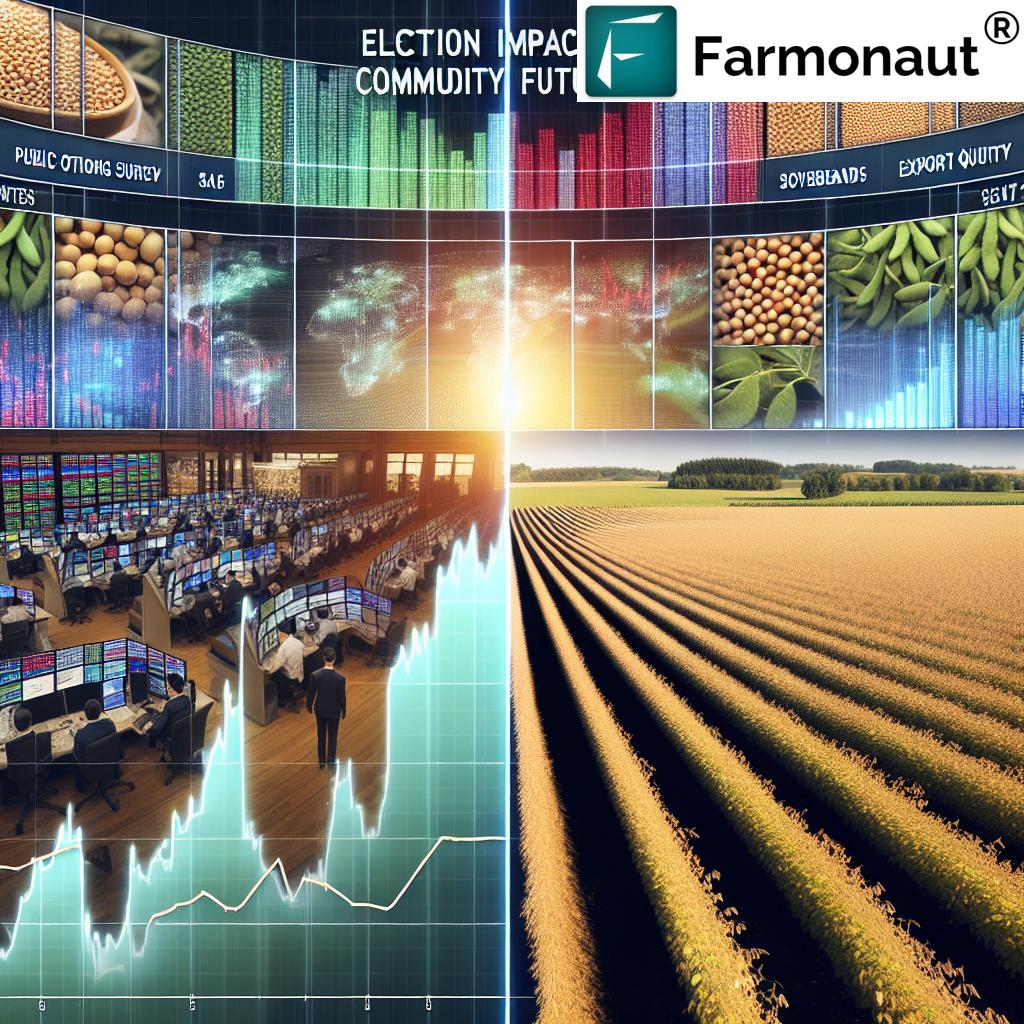US Boosts Global Agricultural Exports: $300 Million Funding to Expand Emerging Markets in Africa, Latin America, and Asia
“US agricultural export promotion funding doubled to $600 million for 2024, targeting emerging markets in Africa, Latin America, and Asia.”
In a landmark move that is set to reshape the landscape of global agricultural markets and US farm exports, we at Farmonaut are excited to explore the implications of the recent $300 million boost in agricultural export promotion funding. This significant investment, which brings the total funding to an impressive $600 million for 2024, marks a pivotal moment in the United States’ strategy to diversify export opportunities and strengthen its position in emerging markets across Africa, Latin America, the Caribbean, and Asia.
As pioneers in satellite-based farm management solutions, we understand the critical role that such initiatives play in advancing international agricultural trade and addressing growing global food demand trends. In this comprehensive analysis, we’ll delve into how this strategic investment is bolstering various agricultural sectors, including grains, feed, and ethanol, and examine the potential long-term effects on agricultural market development and the competitiveness of US producers in the evolving world of agriculture.

Understanding the Regional Agricultural Promotion Program (RAPP)
The U.S. Department of Agriculture (USDA) has taken a bold step forward with the announcement of a second round of funding through the Regional Agricultural Promotion Program (RAPP). This initiative is designed to enhance American food and agricultural exports in emerging global markets, reflecting a strategic approach to agricultural export promotion and market development.
- Total Funding: $600 million for 2024
- New Funding Round: $300 million
- Target Regions: Africa, Latin America, the Caribbean, and South/Southeast Asia
- Focus: Diversifying export markets and tapping into regions with increasing consumer demand and purchasing power
U.S. Agriculture Secretary Tom Vilsack emphasized the significance of RAPP in ensuring that American producers and agribusinesses remain competitive in the dynamic landscape of global trade. This substantial financial commitment aims to augment the global demand for high-quality American agricultural products, supporting sustainable agriculture exports and fostering new trading relationships.
Impact on Various Agricultural Sectors
The latest round of RAPP funding has provided substantial support to several key agricultural trade organizations, each playing a crucial role in expanding US agricultural commodity exports:
U.S. Grains Council (USGC)
- Allocation: $16 million
- Purpose: Further develop markets for U.S. ethanol and feed grains
- Total Funding for 2024: $33 million (including previous $17 million allocation)
Ryan LeGrand, president of USGC, expressed optimism about the potential to broaden and diversify market opportunities for U.S. commodities in both new and traditional markets.
USA Rice
- Allocation: $6.8 million
- Additional Funding: $300,000 for promoting U.S. wild rice
- Total Funding: $13.05 million (including previous $6.25 million award)
Steve Vargas, chair of the USA Rice International Promotion Committee, highlighted the timely nature of this funding, especially in light of pending farm bill extensions related to critical export promotion programs.
American Feed Industry Association (AFIA)
- Allocation: $1 million
- Total Funding: $1.8 million (including previous $800,000 disbursement)
Constance Cullman, President and CEO of AFIA, noted that this funding reinforces their commitment to strengthening ties with international buyers and expanding avenues for American agricultural exports.
Strategies for Export Diversification
The RAPP funding is part of a broader strategy to diversify US agricultural exports and tap into emerging markets. Here are some key strategies being employed:
- Market Research and Analysis: Identifying high-potential markets and consumer trends
- Trade Missions: Organizing targeted trade missions to build relationships with foreign buyers
- Product Adaptation: Tailoring US agricultural products to meet local preferences and regulations
- Digital Marketing: Leveraging online platforms to reach new consumers and buyers
- Capacity Building: Providing technical assistance to help US exporters navigate foreign markets
At Farmonaut, we recognize the importance of these strategies in expanding global agricultural markets. Our satellite-based farm management solutions can play a crucial role in helping US producers optimize their production to meet international demand.
Addressing Global Food Demand Trends
The increased funding for agricultural export promotion comes at a time when global food demand is evolving rapidly. Several trends are shaping the international agricultural trade landscape:
- Rising Middle Class: Growing middle classes in emerging markets are driving demand for high-quality, diverse food products
- Urbanization: Increasing urban populations are changing food consumption patterns
- Health and Wellness: Greater focus on nutritious and functional foods
- Sustainability: Growing demand for sustainably produced agricultural products
- Food Security: Heightened awareness of the need for stable food supplies
The RAPP funding enables US producers to better position themselves to meet these evolving demands, supporting sustainable agriculture exports and fostering new trading relationships.

Long-Term Effects on Agricultural Market Development
The substantial investment in agricultural export promotion is expected to have far-reaching effects on agricultural market development:
- Market Diversification: Reduced reliance on traditional export markets, mitigating risks associated with trade disputes or economic downturns
- Economic Growth: Increased export opportunities contributing to rural economic development in the US
- Innovation: Encouraging product innovation to meet diverse international market demands
- Strengthened Trade Relationships: Building long-term partnerships with emerging economies
- Enhanced Competitiveness: Improving the global competitiveness of US agricultural products
As a company committed to advancing agricultural technology, Farmonaut sees great potential in these developments. Our satellite-based solutions can help US producers optimize their operations to meet the demands of these new markets efficiently.
“A $300 million boost in US agricultural export funding aims to diversify opportunities across three continents and the Caribbean region.”
The Role of Technology in Boosting Agricultural Exports
In the context of expanding agricultural exports, technology plays a pivotal role in enhancing productivity, quality, and sustainability. At Farmonaut, we’re at the forefront of this technological revolution in agriculture:
- Satellite-Based Crop Monitoring: Our advanced satellite imagery technology helps farmers monitor crop health, optimize resource use, and improve yields – crucial factors in producing high-quality exports.
- AI-Driven Insights: Our Jeevn AI Advisory System provides personalized recommendations, helping farmers make data-driven decisions to meet international market standards.
- Blockchain Traceability: Our blockchain solutions ensure transparency in the supply chain, a growing concern for international buyers and consumers.
- Resource Management: Efficient resource management tools help reduce production costs, making US agricultural exports more competitive in global markets.
These technologies not only support the production of high-quality agricultural commodities but also contribute to sustainable farming practices, aligning with global trends towards environmentally responsible agriculture.
Challenges and Opportunities in Emerging Markets
While the increased funding presents significant opportunities, expanding into emerging markets also comes with challenges:
Challenges:
- Regulatory differences and trade barriers
- Cultural and linguistic diversity
- Infrastructure limitations in some regions
- Competition from local and other international producers
Opportunities:
- Rapidly growing consumer bases
- Increasing demand for high-quality, diverse food products
- Potential for long-term market growth
- Opportunities to introduce innovative agricultural products
Navigating these challenges and opportunities requires a strategic approach, and this is where Farmonaut’s technology can provide valuable support. Our data-driven insights can help exporters understand market trends and optimize their production to meet specific regional demands.
Explore Farmonaut’s API for agricultural insights
The Impact on US Farmers and Agribusinesses
The increased funding for agricultural export promotion has significant implications for US farmers and agribusinesses:
- Market Access: Improved access to new and diverse markets, reducing dependency on traditional export destinations
- Price Stability: Diversified markets can help stabilize prices by balancing supply and demand across different regions
- Innovation Incentives: Exposure to new markets encourages product innovation and quality improvements
- Economic Resilience: Broader market reach can help buffer against economic fluctuations in specific regions
- Competitive Advantage: Enhanced support for export activities can give US producers an edge in the global market
At Farmonaut, we’re committed to supporting US farmers and agribusinesses in leveraging these opportunities. Our technology solutions can help producers optimize their operations to meet the specific demands of these new markets efficiently and sustainably.
Sustainable Agriculture and Global Food Security
The expansion of US agricultural exports through this funding initiative also has important implications for global food security and sustainable agriculture:
- Technology Transfer: US agricultural expertise and technology can contribute to improved farming practices in emerging markets
- Sustainable Practices: Promotion of sustainably produced US agricultural products can set global standards
- Food Security: Increased agricultural trade can help balance global food supplies and mitigate regional shortages
- Climate Resilience: US farmers’ experience with climate-smart agriculture can be valuable in addressing global climate challenges
Farmonaut’s satellite-based solutions align perfectly with these goals, offering tools that support sustainable farming practices and help optimize resource use. Our technology can play a crucial role in promoting environmentally responsible agriculture on a global scale.
The Future of US Agricultural Exports
Looking ahead, the increased funding for agricultural export promotion sets the stage for a transformative period in US agricultural trade. We anticipate several key developments:
- Diversified Export Portfolio: A more balanced distribution of exports across various global regions
- Increased Market Share: Potential for significant growth in US market share in emerging economies
- Product Innovation: Development of new products tailored to specific international market preferences
- Enhanced Global Partnerships: Stronger agricultural trade relationships with countries in Africa, Latin America, and Asia
- Technological Integration: Greater adoption of advanced technologies in export-oriented agriculture
As a leader in agricultural technology, Farmonaut is poised to support this future vision. Our continuous innovation in satellite-based farm management and AI-driven insights will play a crucial role in helping US producers meet the evolving demands of the global market.
Comparative Analysis: US Agricultural Export Funding
| Year | Total Funding (in millions) | Primary Target Markets | Key Agricultural Sectors | Estimated Export Growth (%) |
|---|---|---|---|---|
| 2023 | $300 | Traditional markets, limited emerging market focus | Grains, Soybeans, Meat | 2-3% |
| 2024 | $600 | Africa, Latin America, Caribbean, South/Southeast Asia | Grains, Feed, Ethanol, Rice | 5-7% (projected) |
| 2025 (Projected) | $700-$800 (estimated) | Expanded presence in emerging markets, new frontier markets | Diversified portfolio including processed foods, specialty crops | 8-10% (estimated) |
This table clearly illustrates the significant increase in funding and the shift towards emerging markets, highlighting the potential for substantial export growth in the coming years.
Conclusion: A New Era for US Agricultural Exports
The $300 million boost in funding for agricultural export promotion, bringing the total to $600 million for 2024, marks a significant milestone in US agricultural trade strategy. This investment not only demonstrates the country’s commitment to expanding its global agricultural footprint but also reflects a keen understanding of the evolving dynamics of world agriculture.
As we’ve explored throughout this analysis, the implications of this funding are far-reaching:
- Diversification of export markets, particularly in Africa, Latin America, and Asia
- Support for various agricultural sectors, from grains and feed to ethanol and rice
- Potential for significant growth in US agricultural exports
- Opportunities for technological advancement and sustainable farming practices
- Enhanced global food security and stronger international trade relationships
At Farmonaut, we’re excited about the role our satellite-based farm management solutions can play in this new era of US agricultural exports. By providing farmers and agribusinesses with cutting-edge tools for crop monitoring, resource management, and data-driven decision-making, we’re helping to ensure that US agricultural products remain competitive and sought-after in the global marketplace.
As we look to the future, it’s clear that the landscape of international agricultural trade is evolving rapidly. With this substantial investment in export promotion and the continued advancement of agricultural technology, the United States is well-positioned to meet the growing global demand for high-quality, sustainably produced agricultural products. The coming years promise to be an exciting time for US agriculture, with new opportunities emerging across the globe and technology playing an increasingly crucial role in driving success.
FAQs
- Q: What is the Regional Agricultural Promotion Program (RAPP)?
A: RAPP is a USDA initiative designed to enhance American food and agricultural exports in emerging global markets by providing funding for export promotion activities. - Q: How much funding has been allocated for agricultural export promotion in 2024?
A: The total funding for 2024 is $600 million, including a recent boost of $300 million. - Q: Which regions are targeted by this export promotion funding?
A: The funding targets emerging markets in Africa, Latin America, the Caribbean, and South/Southeast Asia. - Q: How does this funding benefit US farmers and agribusinesses?
A: It provides opportunities for market diversification, potential price stability, incentives for innovation, and enhanced competitiveness in global markets. - Q: What role does technology play in supporting agricultural exports?
A: Technology, such as Farmonaut’s satellite-based solutions, helps optimize production, ensure quality, and promote sustainable farming practices, making US exports more competitive.




















